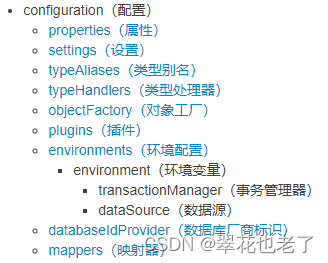mybatis的核心配置文件有两个,一个是全局配置文件,它包含了会深深影响Mybatis行为的设置和属性信息;一个是映射文件,它很简单,让用户能更专注于sql代码。 全局配置文件 全局配置文件的顶层结
mybatis的核心配置文件有两个,一个是全局配置文件,它包含了会深深影响Mybatis行为的设置和属性信息;一个是映射文件,它很简单,让用户能更专注于sql代码。
全局配置文件
全局配置文件的顶层结构如下:

configuration 是整个配置文件的根标签。对应着Mybatis里最重要的配置类Configuration。这个类中的很多属性都和全局配置文件中的子标签对应。
public class Configuration { protected Environment environment; protected boolean safeRowBoundsEnabled; protected boolean safeResultHandlerEnabled; protected boolean mapUnderscoreToCamelCase; protected boolean aggressiveLazyLoading; protected boolean multipleResultSetsEnabled; protected boolean useGeneratedKeys; protected boolean useColumnLabel; protected boolean cacheEnabled; protected boolean callSettersOnNulls; protected boolean useActualParamName; protected boolean returnInstanceForEmptyRow; protected String logPrefix; protected Class<? extends Log> logImpl; protected Class<? extends VFS> vfsImpl; protected LocalCacheScope localCacheScope; protected JdbcType jdbcTypeForNull; protected Set<String> lazyLoadTriggerMethods; protected Integer defaultStatementTimeout; protected Integer defaultFetchSize; protected ResultSetType defaultResultSetType; protected ExecutorType defaultExecutorType; protected AutoMappingBehavior autoMappingBehavior; protected AutoMappingUnknownColumnBehavior autoMappingUnknownColumnBehavior; protected Properties variables; protected ReflectorFactory reflectorFactory; protected ObjectFactory objectFactory; protected ObjectWrapperFactory objectWrapperFactory; protected boolean lazyLoadingEnabled; protected ProxyFactory proxyFactory; protected String databaseId; protected Class<?> configurationFactory; protected final MapperReGIStry mapperRegistry; protected final InterceptorChain interceptorChain; protected final TypeHandlerRegistry typeHandlerRegistry; protected final TypeAliasRegistry typeAliasRegistry; protected final LanguageDriverRegistry languageRegistry; protected final Map<String, MappedStatement> mappedStatements; protected final Map<String, Cache> caches; protected final Map<String, ResultMap> resultMaps; protected final Map<String, ParameterMap> parameterMaps; protected final Map<String, KeyGenerator> keyGenerators; protected final Set<String> loadedResources; protected final Map<String, Xnode> sqlFragments; protected final Collection<XMLStatementBuilder> incompleteStatements; protected final Collection<CacheRefResolver> incompleteCacheRefs; protected final Collection<ResultMapResolver> incompleteResultMaps; protected final Collection<MethodResolver> incompleteMethods; protected final Map<String, String> cacheRefMap;properties标签用来配置参数信息。
为了更加灵活的配置参数,我们把它们放在单独的properties中,用properties标签引入。
这样在xml文件中使用${} 就可以获取到。
属性文件:db.properties:
driver=com.Mysql.cj.jdbc.Driverurl=jdbc:mysql:///tool?useUnicode=true&characterEncoding=utf8username=rootpassWord=root配置文件:mybatis-config.xml:
DOCTYPE configuration PUBLIC "-//mybatis.org//DTD Config 3.0//EN" "https://mybatis.org/dtd/mybatis-3-config.dtd"><configuration> <properties resource="db.properties">properties> <environments default="development"> <environment id="development"> <transactionManager type="JDBC"/> <dataSource type="POOLED"> <property name="driver" value="${driver}"/> <property name="url" value="${url}"/> <property name="username" value="${username}"/> <property name="password" value="${password}"/> dataSource> environment> environments> <mappers> <mapper resource="mapper/DeviceMapper.xml"/> mappers>configuration>这是Mybatis中极为重要的调整配置,它们会改变Mybatis的运行时行为。
一个完整的settings元素示例如下:
<settings> <setting name="cacheEnabled" value="true"/> <setting name="lazyLoadingEnabled" value="true"/> <setting name="aggressiveLazyLoading" value="true"/> <setting name="multipleResultSetsEnabled" value="true"/> <setting name="useColumnLabel" value="true"/> <setting name="useGeneratedKeys" value="false"/> <setting name="autoMappingBehavior" value="PARTIAL"/> <setting name="autoMappingUnknownColumnBehavior" value="WARNING"/> <setting name="defaultExecutorType" value="SIMPLE"/> <setting name="defaultStatementTimeout" value="25"/> <setting name="defaultFetchSize" value="100"/> <setting name="safeRowBoundsEnabled" value="false"/> <setting name="safeResultHandlerEnabled" value="true"/> <setting name="mapUnderscoreToCamelCase" value="false"/> <setting name="localCacheScope" value="SESSION"/> <setting name="jdbcTypeForNull" value="OTHER"/> <setting name="lazyLoadTriggerMethods" value="equals,clone,hashCode,toString"/> <setting name="defaultScriptingLanguage" value="org.apache.ibatis.scripting.xmltags.XMLLanguageDriver"/> <setting name="defaultEnumTypeHandler" value="org.apache.ibatis.type.EnumTypeHandler"/> <setting name="callSettersOnNulls" value="false"/> <setting name="returnInstanceForEmptyRow" value="false"/> <setting name="logPrefix" value="exampleLogPreFix_"/> <setting name="logImpl" value="SLF4J | LOG4J | LOG4J2 | jdk_LOGGING | COMMONS_LOGGING | STDOUT_LOGGING | NO_LOGGING"/> <setting name="proxyFactory" value="CGLIB | JAVASSIST"/> <setting name="vfsImpl" value="org.mybatis.example.YourselfVfsImpl"/> <setting name="useActualParamName" value="true"/> <setting name="configurationFactory" value="org.mybatis.example.ConfigurationFactory"/>settings>类型别名可以为java类型设置一个缩写名字,主要用来简化全类名的书写。
我们可以为单个类指定别名,如:
<typeAliases> <typeAlias type="com.lk.tool.bean.Device" alias="Device"/> typeAliases>我们也可以指定一个包名,将包下所有的Bean都以首字母小写的名称来做别名。
<typeAliases> <package name="com.lk.tool.bean"/> typeAliases>如上所示,com.lk.tool.bean.Device的别名为 device。若类上有注解,别名为其注解值。如下所示:
@Alias("device")public class Device{ ...}MyBatis中有一些预置好的类型别名,在TypeAliasRegistry中。
public TypeAliasRegistry() { this.registerAlias("string", String.class); this.registerAlias("byte", Byte.class); this.registerAlias("long", Long.class); this.registerAlias("short", Short.class); this.registerAlias("int", Integer.class); this.registerAlias("integer", Integer.class); this.registerAlias("double", Double.class); this.registerAlias("float", Float.class); this.registerAlias("boolean", Boolean.class); this.registerAlias("byte[]", Byte[].class); this.registerAlias("long[]", Long[].class); this.registerAlias("short[]", Short[].class); this.registerAlias("int[]", Integer[].class); this.registerAlias("integer[]", Integer[].class); this.registerAlias("double[]", Double[].class); this.registerAlias("float[]", Float[].class); this.registerAlias("boolean[]", Boolean[].class); this.registerAlias("_byte", Byte.TYPE); this.registerAlias("_long", Long.TYPE); this.registerAlias("_short", Short.TYPE); this.registerAlias("_int", Integer.TYPE); this.registerAlias("_integer", Integer.TYPE); this.registerAlias("_double", Double.TYPE); this.registerAlias("_float", Float.TYPE); this.registerAlias("_boolean", Boolean.TYPE); this.registerAlias("_byte[]", byte[].class); this.registerAlias("_long[]", long[].class); this.registerAlias("_short[]", short[].class); this.registerAlias("_int[]", int[].class); this.registerAlias("_integer[]", int[].class); this.registerAlias("_double[]", double[].class); this.registerAlias("_float[]", float[].class); this.registerAlias("_boolean[]", boolean[].class); this.registerAlias("date", Date.class); this.registerAlias("decimal", BigDecimal.class); this.registerAlias("bigdecimal", BigDecimal.class); this.registerAlias("biginteger", BigInteger.class); this.registerAlias("object", Object.class); this.registerAlias("date[]", Date[].class); this.registerAlias("decimal[]", BigDecimal[].class); this.registerAlias("bigdecimal[]", BigDecimal[].class); this.registerAlias("biginteger[]", BigInteger[].class); this.registerAlias("object[]", Object[].class); this.registerAlias("map", Map.class); this.registerAlias("HashMap", HashMap.class); this.registerAlias("list", List.class); this.registerAlias("arraylist", ArrayList.class); this.registerAlias("collection", Collection.class); this.registerAlias("iterator", Iterator.class); this.registerAlias("ResultSet", ResultSet.class); }其中就有熟悉的 string、date、map。
MyBatis在设置预处理语句(PreparedStatement)中的参数或从结果集中取出一个值时,都会用类型处理器将获取到的值以合适的方式转换成Java类型。
由于Java类型和数据库的JDBC类型存在差异,并非万千对应,所以类型处理器的作用很必要。比如 String 与 Varchar、text。
由于MyBatis内置了很多TypeHandler,都注册在TypeHandlerRegistry中,所以当我们查询数据或者插入数据时,不需要特别处理就可以做数据转换,因为它们自动调用了对应的TypeHandler方法。
我们可以重写已有的类型处理器或创建自己的类型处理器,来处理不支持的或非标准的类型。
具体做法为:实现 org.apache.ibatis.type.TypeHandler 接口, 或继承一个很便利的类 org.apache.ibatis.type.BaseTypeHandler, 并且可以(可选地)将它映射到一个 JDBC 类型。比如:我们针对card_no字段做一个特别处理,使用掩码将中间11位置*。
首先写一个自定义的StringTypeHandler类:
package com.lk.tool.typehandler;import com.alibaba.excel.util.StringUtils;import org.apache.ibatis.type.BaseTypeHandler;import org.apache.ibatis.type.JdbcType;import java.sql.*;public class StringTypeHandler extends BaseTypeHandler<String> { @Override public void setNonNullParameter(PreparedStatement ps, int i, String parameter, JdbcType jdbcType) throws SQLException { ps.setString(i,parameter); } @Override public String getNullableResult(ResultSet rs, String columnName) throws SQLException { String obj = (String)rs.getObject(columnName); System.out.println(obj); if("card_no".equals(columnName) && StringUtils.isNotBlank(obj)){ StringBuffer buffer = new StringBuffer(); return buffer.append(obj.substring(0,6)).append("***********").append(obj.substring(17)).toString(); } return rs.getString(columnName); } @Override public String getNullableResult(ResultSet rs, int columnIndex) throws SQLException { return rs.getString(columnIndex); } @Override public String getNullableResult(CallableStatement cs, int columnIndex) throws SQLException { return cs.getString(columnIndex); }}在全局配置文件 mybatis-config.xml中增加如下配置项:
<typeHandlers> <typeHandler handler="com.lk.tool.typehandler.StringTypeHandler">typeHandler> typeHandlers>即可实现掩码功能:(输出查询结果)
Device(id=2, sn=2234567, cardNo=120223***********4)每次MyBatis 创建结果对象的新实例时,它都会使用一个对象工厂(ObjectFactory)实例来完成实例化工作。默认的对象工厂需要做的仅仅是实例化目标类,要么通过默认无参构造方法,要么通过存在的参数映射来调用带有参数的构造方法。
如果想覆盖对象工厂的默认行为,可以通过创建自己的对象工厂来实现。例如:
// ExampleObjectFactory.javapublic class ExampleObjectFactory extends DefaultObjectFactory { @Override public <T> T create(Class<T> type) { return super.create(type); } @Override public <T> T create(Class<T> type, List<Class<?>> constructorArgTypes, List<Object> constructorArgs) { return super.create(type, constructorArgTypes, constructorArgs); } @Override public void setProperties(Properties properties) { super.setProperties(properties); } @Override public <T> boolean isCollection(Class<T> type) { return Collection.class.isAssignableFrom(type); }}<objectFactory type="org.mybatis.example.ExampleObjectFactory"> <property name="someProperty" value="100"/>objectFactory>ObjectFactory 接口很简单,包含两个创建实例用的方法,一个是处理默认无构造方法的,另外一个是处理带参数的构造方法的。另外 setProperties 方法可以被用来配置ObjectFactory,在初始化你的ObjectFactory实例后,objectFactory元素体中定义的属性会被传递给 setProperties 方法。
MyBatis允许我们在映射语句执行过程中的某一点进行拦截调用。
默认情况下,MyBatis允许使用插件来拦截的方法调用包括:
Executor (update, query, flushStatements, commit, rollback, getTransaction, close, isClosed)
ParameterHandler (getParameterObject, setParameters)
ResultSetHandler (handleResultSets, handleOutputParameters)
StatementHandler (prepare, parameterize, batch, update, query)
这些类中方法的细节可以通过查看每个方法的签名来发现。
只需要实现Interceptor接口,并制定想要拦截的方法,即可使用插件。
如下示例,会拦截在Executor实例中所有的“update” 方法调用,这里的Executor是负责执行底层映射语句的内部对象。
// ExamplePlugin.java@Intercepts({@Signature( type= Executor.class, method = "update", args = {MappedStatement.class,Object.class})})public class ExamplePlugin implements Interceptor { private Properties properties = new Properties(); @Override public Object intercept(Invocation invocation) throws Throwable { // implement pre processing if need Object returnObject = invocation.proceed(); // implement post processing if need return returnObject; } @Override public void setProperties(Properties properties) { this.properties = properties; }}<plugins> <plugin interceptor="org.mybatis.example.ExamplePlugin"> <property name="someProperty" value="100"/> plugin>plugins>environment标签用来管理数据库的环境,比如我们可以有开发环境、测试环境、生产环境的数据库。可以在不同的环境中使用不同的数据库地址或类型。
<environments default="development"> <environment id="development"> <transactionManager type="JDBC"/> <dataSource type="POOLED"> <property name="driver" value="${driver}"/> <property name="url" value="${url}"/> <property name="username" value="${username}"/> <property name="password" value="${password}"/> dataSource> environment> environments>envionment
一个environment标签就是一个数据源,代表一个数据库。这里有两个标签
○ transactionManager(事务管理器)
如果配置的是JDBC,则会使用Connection对象的commit()、rollback()、close()管理事务。
如果配置成MANAGE,会把事务交给容器来管理,比如WEBlogic。如果我们跑的是本地服务,那么配置MANAGE不会有任务事务。
如果是spring + Mybatis,则不必配置。我们会直接在 applicationContext.xml里面配置数据源和事务,覆盖MyBatis的配置。
○ dataSource(数据源)
一个数据源就对应一个数据库。
一般数据源都包括连接池的管理功能,所以DataSource也经常被称为连接池,或者是带连接池功能的数据源。
既然 MyBatis 的行为已经由上述元素配置完了,我们现在就要来定义 SQL 映射语句了。
如下这些配置会告诉 MyBatis 去哪里找映射文件
<mappers> <mapper resource="org/mybatis/builder/AuthORMapper.xml"/> <mapper resource="org/mybatis/builder/BlogMapper.xml"/> <mapper resource="org/mybatis/builder/PostMapper.xml"/>mappers><mappers> <mapper url="file:///var/mappers/AuthorMapper.xml"/> <mapper url="file:///var/mappers/BlogMapper.xml"/> <mapper url="file:///var/mappers/PostMapper.xml"/>mappers><mappers> <mapper class="org.mybatis.builder.AuthorMapper"/> <mapper class="org.mybatis.builder.BlogMapper"/> <mapper class="org.mybatis.builder.PostMapper"/>mappers><mappers> <package name="org.mybatis.builder"/>mappers>关于映射文件的细节,我们下篇文章详细讨论。
--结束END--
本文标题: Mybatis的核心配置文件
本文链接: https://www.lsjlt.com/news/396666.html(转载时请注明来源链接)
有问题或投稿请发送至: 邮箱/279061341@qq.com QQ/279061341
下载Word文档到电脑,方便收藏和打印~
2024-05-14
2024-05-14
2024-05-14
2024-05-14
2024-05-14
2024-05-13
2024-05-13
2024-05-13
2024-05-13
2024-05-12
回答
回答
回答
回答
回答
回答
回答
回答
回答
回答
0